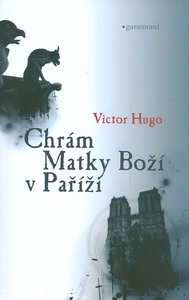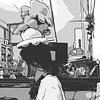You need to sign in or sign up before continuing.
Take a photo of a barcode or cover
challenging
dark
emotional
slow-paced
For book group. Very dutiful. Had to give a miss to the entire chapter imagining the view from the roof of Notre Dame ca. 1500. No point without maps of Paris for both 1500 and the late 1800s. I found some spots affecting, but it was heavy sledding. Heavy on the melodramatic. Les Miserables is plenty melodramatic as well but better grounded and more consistent, much more entertaining.
Sconvolgente.
Non avrei mai immaginato un finale simile e questo non fa che aumentare il mio amore per Hugo, perché con questo romanzo ha dimostrato di avere a cuore la verosimiglianza delle storie che racconta più del semplice lieto fine.
Ogni personaggio è strutturato in modo singolare e il messaggio più importante ritengo sia questo: "Niente - e nessuno - è ciò che appare".
Non avrei mai immaginato un finale simile e questo non fa che aumentare il mio amore per Hugo, perché con questo romanzo ha dimostrato di avere a cuore la verosimiglianza delle storie che racconta più del semplice lieto fine.
Ogni personaggio è strutturato in modo singolare e il messaggio più importante ritengo sia questo: "Niente - e nessuno - è ciò che appare".
dark
medium-paced
Plot or Character Driven:
Character
Strong character development:
No
Loveable characters:
Complicated
Diverse cast of characters:
Yes
Flaws of characters a main focus:
Yes
Graphic: Ableism, Racism
adventurous
challenging
dark
informative
mysterious
tense
slow-paced
Plot or Character Driven:
A mix
Strong character development:
Yes
Loveable characters:
Complicated
Diverse cast of characters:
Yes
Flaws of characters a main focus:
Yes
Much darker than I was expecting, which is always a welcome surprised, but the changes in Point of view between minor characters that I barely cared made the book feel very long. It also surprised me that my favorite parts were the rants and essays that Hugo inserted here and there about the beauty and importance of Notre-Dame, Paris architecture and the weight of time passing. I stayed because of it, for the feeling of a hectic city and the descriptions of the everyday life way back then.
Tiene mucho más sentido que el título del libro sea "Notre-Dame de París", porque te indica que ese es el centro de la novela, todo lo que sucede alrededor de ella, y no como lo han traducido en otras ediciones o países ("El jorobado de ND"), porque Quasimodo es un personaje principal pero todo es acerca de él. Va mucho más allá, es sobre la increíble obra que es Notre-Dame. En aquel entonces, ahora y por muchos años más.
Tiene mucho más sentido que el título del libro sea "Notre-Dame de París", porque te indica que ese es el centro de la novela, todo lo que sucede alrededor de ella, y no como lo han traducido en otras ediciones o países ("El jorobado de ND"), porque Quasimodo es un personaje principal pero todo es acerca de él. Va mucho más allá, es sobre la increíble obra que es Notre-Dame. En aquel entonces, ahora y por muchos años más.
God bless the French people. Their best are really better than the best of other cultures. Victor Hugo breathes life into a whole city, (a city that lived some >300 years before his time), and particularly a Gothic Cathedral of mythical character. Paris' people ranging from the King to lowly beggars walk about driving the story, or simply populating the city. Apparently this is the first Western novel to feature protagonists from the vagabond class.
So Hugo has a thing for Gothic architecture. I don’t share this interest, (in fact, I found descriptions of architecture in the book quite tedious to go through), but I couldn’t help get drawn into it in by the end. There’s an enormous and magnificent set-piece towards the end set in Notre Dame, and thus the claim that Notre Dame is the true protagonist of the novel is no exaggeration.
The plot is driven by a lot of misunderstandings, and normally I find that lazy and off-putting, but of course it is not done lazily in this novel, and all of them make sense thematically. Notre Dame de Paris is a modern (Romantic?) writer looking at the feudal structure of medieval Paris and exposing the various contradictions and absurdities of that society. Love doesn’t affirm life, beauty is bane, piety is obsession, monarchy is anything but regal. The characters are all satisfyingly complex; though not that complex, just enough to not bore me.
What struck me the most was that Notre Dame de Paris employs a lot of writing techniques that I associated with post-1900 novels. It is still quite old-fashioned in many ways, to be sure, but there’s a lot of irony in the tale, wit and sarcasm in dialogue that were pleasantly surprising. Not to mean these are not found in older literature, but that I expect them to be of a different sort. I mean I don’t have to think like a person living in 1830 to get the author’s wit in the novel. Hugo speaks to Pavan of 2020.
So Hugo has a thing for Gothic architecture. I don’t share this interest, (in fact, I found descriptions of architecture in the book quite tedious to go through), but I couldn’t help get drawn into it in by the end. There’s an enormous and magnificent set-piece towards the end set in Notre Dame, and thus the claim that Notre Dame is the true protagonist of the novel is no exaggeration.
The plot is driven by a lot of misunderstandings, and normally I find that lazy and off-putting, but of course it is not done lazily in this novel, and all of them make sense thematically. Notre Dame de Paris is a modern (Romantic?) writer looking at the feudal structure of medieval Paris and exposing the various contradictions and absurdities of that society. Love doesn’t affirm life, beauty is bane, piety is obsession, monarchy is anything but regal. The characters are all satisfyingly complex; though not that complex, just enough to not bore me.
What struck me the most was that Notre Dame de Paris employs a lot of writing techniques that I associated with post-1900 novels. It is still quite old-fashioned in many ways, to be sure, but there’s a lot of irony in the tale, wit and sarcasm in dialogue that were pleasantly surprising. Not to mean these are not found in older literature, but that I expect them to be of a different sort. I mean I don’t have to think like a person living in 1830 to get the author’s wit in the novel. Hugo speaks to Pavan of 2020.
Really liked some of it, though 20 pages on the description of Paris was a little unnecessary.
I read this novel as part of a project in which I'm reading the original works which Disney movies are based on. While the novel was certainly darker than the movie, I am intrigued by the fact that Hugo's detailed descriptions of the architecture of Paris brought the Notre Dame particularly to life, almost as explicitly as if the gargoyles had actually talked, as they do in the Disney movie. I was also struck by similarities to Great Expectations, particularly when it came to the mysterious backstories of Quasimodo, Esmeralda, and the Sachette. Other than these characters, and in some ways Frollo, as twisted as he was, I found all the characters quite shallow. It the was in some ways unsettling to read, but moments like the Sachette's fierce protection of Esmeralda, Esmeralda's kindnesss to Gringoire and Quasimodo when they were at the mercy of the justice systems of Paris, and Quasimodo's cries of "Sanctuar!" grounded the story. I was intrigued that Hugo addressed the injustice of the "justice" system and society in general, particularly through the device of the Court of Miracles, which, as it turns out, is no more arbitrary or cruel than the actual Palace of Justice. Despite the heavy material and tragic ending, the novel was at points quite funny and, once I got past the entirely architectural chapters, an absorbing read.
dark
reflective
sad
tense
slow-paced
Plot or Character Driven:
A mix
Strong character development:
Complicated
Loveable characters:
Complicated
Diverse cast of characters:
Yes
Flaws of characters a main focus:
Yes




